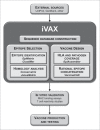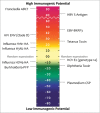iVAX: An integrated toolkit for the selection and optimization of antigens and the design of epitope-driven vaccines
- PMID: 26155959
- PMCID: PMC4635942
- DOI: 10.1080/21645515.2015.1061159
iVAX: An integrated toolkit for the selection and optimization of antigens and the design of epitope-driven vaccines
Abstract
Computational vaccine design, also known as computational vaccinology, encompasses epitope mapping, antigen selection and immunogen design using computational tools. The iVAX toolkit is an integrated set of tools that has been in development since 1998 by De Groot and Martin. It comprises a suite of immunoinformatics algorithms for triaging candidate antigens, selecting immunogenic and conserved T cell epitopes, eliminating regulatory T cell epitopes, and optimizing antigens for immunogenicity and protection against disease. iVAX has been applied to vaccine development programs for emerging infectious diseases, cancer antigens and biodefense targets. Several iVAX vaccine design projects have had success in pre-clinical studies in animal models and are progressing toward clinical studies. The toolkit now incorporates a range of immunoinformatics tools for infectious disease and cancer immunotherapy vaccine design. This article will provide a guide to the iVAX approach to computational vaccinology.
Keywords: Cancer immunotherapy; HLA; T cell; computational vaccinology; conservatrix; epiMatrix; epitope; epitope-based vaccine; epitope-driven vaccine; iVAX; immunoinformatics; janusMatrix.
Figures








Similar articles
-
Better Epitope Discovery, Precision Immune Engineering, and Accelerated Vaccine Design Using Immunoinformatics Tools.Front Immunol. 2020 Apr 7;11:442. doi: 10.3389/fimmu.2020.00442. eCollection 2020. Front Immunol. 2020. PMID: 32318055 Free PMC article. Review.
-
New Immunoinformatics Tools for Swine: Designing Epitope-Driven Vaccines, Predicting Vaccine Efficacy, and Making Vaccines on Demand.Front Immunol. 2020 Oct 5;11:563362. doi: 10.3389/fimmu.2020.563362. eCollection 2020. Front Immunol. 2020. PMID: 33123135 Free PMC article. Review.
-
Immunoinformatics: In Silico Approaches and Computational Design of a Multi-epitope, Immunogenic Protein.Int Rev Immunol. 2019;38(6):307-322. doi: 10.1080/08830185.2019.1657426. Epub 2019 Sep 3. Int Rev Immunol. 2019. PMID: 31478759
-
Computational tools for epitope vaccine design and evaluation.Curr Opin Virol. 2015 Apr;11:103-12. doi: 10.1016/j.coviro.2015.03.013. Epub 2015 Mar 31. Curr Opin Virol. 2015. PMID: 25837467 Free PMC article. Review.
-
Current progress of immunoinformatics approach harnessed for cellular- and antibody-dependent vaccine design.Pathog Glob Health. 2018 May;112(3):123-131. doi: 10.1080/20477724.2018.1446773. Epub 2018 Mar 12. Pathog Glob Health. 2018. PMID: 29528265 Free PMC article.
Cited by
-
Differential functional patterns of memory CD4+ and CD8+ T-cells from volunteers immunized with Ty21a typhoid vaccine observed using a recombinant Escherichia coli system expressing S. Typhi proteins.Vaccine. 2020 Jan 10;38(2):258-270. doi: 10.1016/j.vaccine.2019.10.020. Epub 2019 Oct 16. Vaccine. 2020. PMID: 31629569 Free PMC article.
-
In silico methods for immunogenicity risk assessment and human homology screening for therapeutic antibodies.MAbs. 2024 Jan-Dec;16(1):2333729. doi: 10.1080/19420862.2024.2333729. Epub 2024 Mar 27. MAbs. 2024. PMID: 38536724 Free PMC article.
-
8th vaccine renaissance: A creative nexus for vaccine developers.Hum Vaccin Immunother. 2015;11(9):2294-5. doi: 10.1080/21645515.2015.1069453. Epub 2015 Jul 9. Hum Vaccin Immunother. 2015. PMID: 26158225 Free PMC article. No abstract available.
-
Multi-antigen Vaccination With Simultaneous Engagement of the OX40 Receptor Delays Malignant Mesothelioma Growth and Increases Survival in Animal Models.Front Oncol. 2019 Aug 2;9:720. doi: 10.3389/fonc.2019.00720. eCollection 2019. Front Oncol. 2019. PMID: 31428586 Free PMC article.
-
Bacterial Immunogenicity Prediction by Machine Learning Methods.Vaccines (Basel). 2020 Nov 30;8(4):709. doi: 10.3390/vaccines8040709. Vaccines (Basel). 2020. PMID: 33265930 Free PMC article.
References
-
- Jaiswal V, Chanumolu SK, Gupta A, Chauhan RS, Rout C. Jenner-predict server, prediction of protein vaccine candidates (PVCs) in bacteria based on host-pathogen interactions. BMC Bioinformatics. 2013; 14,211; PMID,; http,//dx.doi.org/10.1186/1471-2105-14-211 - DOI - PMC - PubMed
-
- Doytchinova IA, Flower DR. VaxiJen, a server for prediction of protective antigens, tumour antigens and subunit vaccines. BMC Bioinformatics. 2007; 8,4; PMID,; http,//dx.doi.org/10.1186/1471-2105-8-4 - DOI - PMC - PubMed
-
- Vita R, Overton JA, Greenbaum JA, Ponomarenko J, Clark JD, Cantrell JR, Wheeler DK, Gabbard JL, Hix D, Sette A, Peters B. The immune epitope database (IEDB) 3.0. Nucleic Acids Res. 2015. January;43(Database issue),D405-12; http,//dx.doi.org/10.1093/nar/gku938 - DOI - PMC - PubMed
-
- De Groot A.S., and Martin W.. From immunome to vaccine, epitope mapping and vaccine design tools. In, Novartis Foundation. Immunoinformatics, bioinformatic strategies for better understanding of immune function. Editors Petrovsky and Brusic. Novartis Found Symp 2003; 254; PMID, - PubMed
-
- Petrovsky N, Brusic V. Computational immunology, the coming of age. Immunol Cell Biol 2002; 80,248-54; PMID,; http,//dx.doi.org/10.1046/j.1440-1711.2002.01093.x - DOI - PubMed
MeSH terms
Substances
LinkOut - more resources
Full Text Sources
Other Literature Sources
Research Materials
